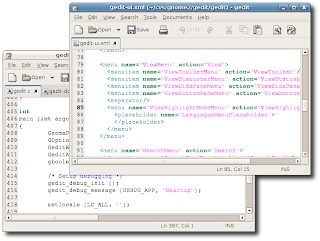Gedit (http://www.gnome.org/projects/gedit/)
 gedit is a small and lightweight text editor for the GNOME environment.
gedit is a small and lightweight text editor for the GNOME environment.Complete GNOME integration is provided, with support for Drag and Drop (DnD) from Nautilus (the GNOME file manager), the use of the GNOME help system, the GNOME Virtual File System and the GNOME print framework.
gedit uses a Multiple Document Interface (MDI), which lets you edit more than one document at the same time.
gedit supports most standard editing features, plus several not found in your average text editor (plugins being the most notable of these).
Features include:
* Complete support for internationalized text (UTF-8)
* Configurable syntax highlighting for various languages (C, C++, Java, HTML, XML, Python, Perl and many others)
* GNOME VFS support for remote files
* Complete integration with the GNOME Environment
* Search and Replace
* Clipboard support
* Text wrapping
* Undo/Redo
* File Revert
* Editing files from remote locations
* A complete preferences interface
* Configurable Plugins system, with optional python support
* Bracket matching
* Backup files
* Printing and Print Previewing Support
* Complete online user manual
Kedit (http://kate-editor.org/)
Kate is a multi document editor which is part of the kdebase package of KDE, the K Desktop Environment.
With a multi-view editor like Kate you get a lot of advantages. You can view several instances of the same document and all instances are synced. Or you can view more files at the same time for easy reference or simultaneous editing. The terminal emulation and sidebar are docked windows that can be plugged out of the main window, or replaced therein according to your preference.
Features include:
* Powerful syntax highlighting and bracket matching
* MDI, window splitting, window tabbing
* Spell checking
* CR, CRLF, LF newline support
* Encoding support (utf-8, utf-16, ascii etc.)
* Encoding conversion
* Search and replace text using regular expressions
* Drag and drop text editing
* Code and text folding
* Infinite undo/redo support
* Block selection mode
* Auto indentation
* Auto completion support
* Integrated shell
* Wide protocol support (http, ftp, ssh, webdav etc.)
* Plugin architecture for the application and editor component
* Customizable shortcuts
* Integrated command line
* Full DCOP scripting
* Scriptable using JavaScript (KDE 3.5)
Scribes (http://scribes.sourceforge.net/)
Scribes is a text editor for GNOME that focuses on streamlining your workflow.
It does so by ensuring common and repetitive operations are intelligently automated, and also by eliminating factors that prevent the user from focusing on his or her tasks.
Scribes does not try to be a complicated integrated development environment (IDE), or a pseudo IDE. Instead, Scribes focuses exclusively on powerful text processing and manipulation.
Scribes is a spatial and document-centric application. Consequently, it is not designed to use tabbed windows.
Features include:
* Extensible via Python plugins
* Remote editing (ftp, sftp, ssh, samba, webdav, webdavs)
* Snippets!
* Automatic word completion
* Automatic correction and replacement
* Automatic pair character completion and smart insertion
* Automatic indentation
* Powerful text processing and manipulation functions
* Bookmarks and smart navigation
* Document Switcher
* Syntax colors for over 30 languages
Cream (http://cream.sourceforge.net/)
Cream is billed as a modern configuration of the Vim text editor. Cream is a set of scripts and add-ons that sit on top of gVim.
Vim is a powerful and full-featured console based text editor. However, Vim is regarded as taking some time to master. Through common menus, keyboard shortcuts, and extensive editing functions, Cream makes Vim approachable for new users and adds powerful features for experienced users.
Cream shapes Vim into an interface you probably already know (sometimes called Common User Access). Whether you are writing emails or developing large software applications, Cream aims to save you time and get you up and running quickly.
The goal of the project is to provide an approachable text editing application with keyboard shortcut and menu access to Vim's full arsenal of functionality
Features include:
* Edits and converts Microsoft, Unix and Apple format text documents
* Supports editing of very large files, size is limited by diskspace
* Encoding support for 38 varieties of 8-bit, 2-byte, and Unicode
* A single editing mode. (Cream does not use Vim's modal editing unless turned on from the Preferences menu)
* Tabbed document interface
* Have multiple documents open at a time
* User-selected font, window size/position and most other settings are retained and restored automatically
* Standard and intuitive menus. All functionality is available through pull down menus which indicate available keyboard shortcuts
* Syntax highlighting makes reading code easier for more than 350 programming languages
* Unlimited Undo/Redo
* Automatic text indention
* Block indention or unindention (with selection, Tab and Shift+Tab)
* Bookmarking with visible margin marks
* Spell checking with alternative spelling suggestions and auto-correction. Many languages are supported
* File explorer window
* Programmer Features such as line golding, Template completion based on file types, Ctags navigation, and Expert mode
* Additional functionality through add-ons, modules that can provide a vast library of functionality including converting text to HTML, Hex to ASCII, Email Prettyfier, Email Munge, Encrypt, and a Slide Generator








1 comments:
The advantages of Kate actually extend beyond Kate itself; Quanta Plus, the superb web editor, and KDevelop, the esteemed multi-language IDE, both have Kate at their kore, er, I mean core.
Post a Comment